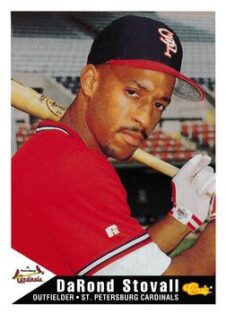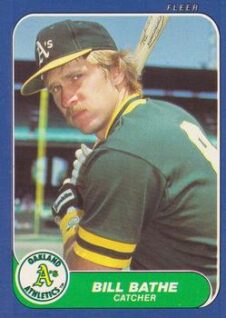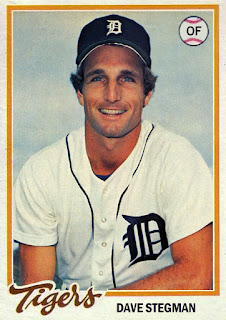You’ve probably never heard of DaRond Stovall, Doug Simons, Bill Bathe, or Dave Stegman. Stovall currently is a Starbucks trainer in Creve Coeur, Missouri. Simons coaches baseball at a small college in Georgia. Bathe is a retired firefighter and paramedic in Tucson, Arizona. Stegman just retired as an actuary with an insurance company in Ohio. All four are former Major League Baseball (MLB) players. Yet, with the 2022 major league baseball season currently in limbo because of the club owners’ locking out the players, it is players like Stovall, Simons, Bathe, and Stegman that fans should be thinking about rather than the multimillion-dollar stars.
Stovall, Simons, Bathe, and Stegman all had what pro baseball players call a “cup of coffee” in the big leagues. As ballplayers, they were not well-known and they didn’t stay long. Stovall spent one year in the majors, Simons spent parts of two seasons playing at that level, and Bathe was a catcher for the San Francisco Giants and Oakland Athletics for parts of three seasons. Stegman was on the rosters of the Detroit Tigers, the New York Yankees, and the Chicago White Sox for parts of six seasons from 1978 to 1982. Their stories are similar to those of thousands of other ballplayers who reach the pinnacle of success—playing in the big leagues—but don’t stay long enough to obtain economic security.
 The owners locked out the players on December 2 after failing to reach an agreement on a new contract with the Major League Baseball Players Association (MLBPA). Negotiations between the two sides have recently stalled, after owners refused to respond to the union’s latest proposal. That makes it unlikely that the owners and union will reach a settlement before spring training is scheduled to begin on February 15.
The owners locked out the players on December 2 after failing to reach an agreement on a new contract with the Major League Baseball Players Association (MLBPA). Negotiations between the two sides have recently stalled, after owners refused to respond to the union’s latest proposal. That makes it unlikely that the owners and union will reach a settlement before spring training is scheduled to begin on February 15.
The battle between the owners and players has been characterized by the media as a fight between “billionaires and millionaires.” That’s only partly true. All 30 major league teams are valued at more than a billion dollars. Most of the team owners are billionaires. Many inherited their wealth or made it in other sectors, such as real estate, banking and finance, and communications. The wealthiest among them, Mets owner Steve Cohen, is worth $11 billion dollars and built his fortune in the hedge fund industry.
Many players make substantial annual incomes, and the superstars earn additional income from endorsements. But few major leaguers accumulate enough savings or pensions to retire and live comfortably. They have to work like the rest of us—and only a handful make anything close to what they earned during the few months or years they wore a major league uniform.
In fact, the “billionaires vs. millionaires” view is a distorting cliché, ignoring the reality that the vast majority of players who reach the big leagues are closer to Stovall, Simons, Bathe, and Stegman than they are to Corey Seager, who, before the lockout halted all transactions, signed a 10-year $325 million deal with the Texas Rangers.
Popular
"swipe left below to view more authors"Swipe →
What’s missing from these stories is that while the average major league salary is $4 million, the median yearly salary is $1.2 million. The average is skewed upward by the mega-salaries of a handful of top players. The 100 highest-paid players earn 52.4 percent of all salaries. Forty percent of players make the MLB minimum salary of $570,000.
Few fans will be shedding tears for the players reading these numbers, but before you yell about players’ being spoiled rich kids, remember that the player you are screaming at may not be in the majors next year. Twenty-five percent of players last only one season. The average service time of MLB players was 4.79 years in 2003 and fell to 3.71 years in 2019, the most recent year for which figures are available. (A year of service time is 187 days, based on the current collective bargaining agreement between MLB and the players union). In other words, the typical player spends less than four years in the major leagues before he is released or injured or he voluntarily retires. Many of them stay on major league rosters for a part of those seasons, so while they may play in the majors for four seasons, they don’t make a full major league salary and their pension payments only reflect time spent in the major leagues.
The MLBPA overturned the infamous reserve clause—baseball’s version of indentured servitude—in 1975. Since then, players can negotiate for better salaries and benefits after they reach six years of service time and become free agents. They are eligible for salary arbitration—with some exceptions—after three years. But most players in the big leagues don’t last long enough to qualify for free agency or even arbitration.
A former major league pitcher who did not want to be identified pointed out that most of his professional career was spent in the minor leagues where he made between $7,000 and $10,000 a year. “It was so strange, he said. “I was so close to being in the big leagues, but I qualified for and received food stamps.”
According to Bathe, who was drafted out of Pepperdine University in 1981 and who hit a three-run home run for the Giants in the 1989 World Series against Oakland, many fans don’t understand the personal and physical sacrifices it takes to make it to the big leagues.
“The misconception is that we’re just spoiled and overpaid and we’re just out there playing a game,” Bathe said. “They don’t understand how quickly your career can come to an end.”
A huge earthquake during the second game of the 1989 World Series between the A’s and the Giants required a 10-day hiatus before play was resumed. During that period, Bathe, then playing for the Giants, began volunteering to help the quake’s victims, working alongside police, firefighters, and other first responders. That experience, he explained, “kind of planted the seed in me. I enjoyed helping people.”
After the Giants released him in 1990, Bathe played in Japan for two years before he joined the Tucson Fire Department, where he spent 27 years, achieving the rank of captain.
After Simons graduated from Pepperdine University with a degree in education in 1988, he was drafted in the ninth round by the Minnesota Twins. His major league career consisted of 49 pitching appearances and 66 innings in two seasons—1991 and 1992. Hoping to make a comeback, he played in the minors until 1997, pitching for seven different teams, as well as pro leagues in Venezuela and Italy. He showed flashes of excellence, but never got another shot at the big leagues.
During his one full year in the majors in 1991, Simons earned the minimum salary of $100,000—the equivalent of $198,427 today. In 1992 he pitched in seven games and was paid a pro-rata salary based on the number of days he was on the Montreal Expos’ roster.
“You don’t know how long you’re going to be there,” Simons said. “If you’re not on the 40-man roster, you’re in the minors and you’re making minor league salary, and working in the off-season as hard as you can to make ends meet.”
“I made about $750 a month in the minors,” he recalled. “My wife supported us by waiting on tables.”
In 2005, tiny Covenant College, a Christian institution with 800 students near Atlanta, recruited Simons to start a baseball program, which competes in Division III.
“I took a vow of poverty to teach here,” he jokes, “but it’s what I wanted to do, to be in a Christian environment.”
Stovall spent 13 years in the minor leagues pursuing his dream. “It was lonely and tough at times,” Stovall said.
 Stovall, an African American, grew up in East St. Louis watching Cardinal greats Willie McGee and Ozzie Smith and wanted to compete at their level. Stovall’s highlight was hitting a ninth inning grand-slam home run for Montreal against the Atlanta Braves during his one year in the majors in 1998.
Stovall, an African American, grew up in East St. Louis watching Cardinal greats Willie McGee and Ozzie Smith and wanted to compete at their level. Stovall’s highlight was hitting a ninth inning grand-slam home run for Montreal against the Atlanta Braves during his one year in the majors in 1998.
“I had my son late in my career, which is one of the reasons I decided to stop playing,” he explained.
After leaving pro baseball, Stovall earned undergraduate and graduate degrees, while working at Starbucks to help pay the bills. Today, in addition to working full-time as a Starbucks trainer, he also works as a part-time assistant baseball coach at Whitfield School, a private institution outside St. Louis, and runs his own baseball training program with about 40 high schoolers.
“I try to educate people that only a few players make millions of dollars and that most players, like me, never reach free agency,” Stovall commented. “I feel blessed for the opportunity I did have, but I obviously had to find another way other than baseball to make a living.”
Stegman, who was a first-round draft pick by the Tigers after graduating from the University of Arizona, earned $500 a month when he started playing in the minors.
“I was like, this is amazing. They’re paying me to do what I love to do. They could have paid me anything,” said Stegman, an outfielder.
He spent 11 years in professional baseball, playing in 1156 games, mostly for Triple-A teams, the top of the minor league system. Only 172 of those games were in the majors. During the six seasons he played on big-league clubs, the minimum salary rose from $21,000 to $40,000, but Stegman only saw a fraction of that because of his limited time on the major league rosters.
“You realize pretty quick that [baseball] is a business,” Stegman said, noting that marginal players like himself spend most of their careers going up and down between the major and minor leagues. “There’s 25 guys on a team and maybe five superstars.”
“There were a couple of times during my career when I was 26th man on a 25-man squad,” he recalled with a laugh.
His minor league income, “was just enough to make ends meet” as a single person, Stegman explained. “But it wasn’t enough to raise a family. So I told myself, if I’m 32, and I’m not in the big leagues, that’s it. I’m done. And I need to get a real job.”
Stegman met his wife while playing for a minor league team in Columbus, Ohio, so they decided to settle there after he left baseball behind. Eleven years after he’d earned a degree as an engineering math major, he found a job as an actuary with an insurance company, and remained in that industry until he retired last year. He and his wife have two children in their 30s. His wife has long worked for the county Children’s Services department, and along with Social Security and his small baseball pension, “we’re comfortable,” he said.
“We don’t have an extravagant lifestyle, but that’s not what I was working for. We got our kids through college. I can’t complain.”
Many fans are cursing both the owners and the players for the current stalemate. There have been five player-led strikes (1972, 1980, 1981,1985, and 1994–95) and four owner-initiated lockouts (1973, 1976, 1990, 2021–22). The strikes focused on pensions, wages, and working conditions. The lockouts were precipitated by the owners’ efforts to limit player salaries and pensions.
This year is no different. Baseball Commissioner Robert Manfred Jr. has accused the players’ union of preferring “confrontation over compromise,” while the players are focused on eliminating owners’ incentives to allow their teams to do poorly (also known as “tanking”) by not spending enough to field the best players. The teams with the worst win-loss records at the end of the season get the early draft picks among high school and college players.
The MLBPA sees the owners’ stance as another attempt to weaken or break the union’s historic strength and solidarity, especially when the teams are prospering at historical levels. The average value of major league teams increased to an all-time high of $1.9 billion in 2020, before the pandemic. Baseball’s revenue from TV deals with ESPN, Fox, and TBS grew from $1.55 billion in 2021 to $1.84 billion starting this year—a 19 percent increase. Meanwhile, the median player salary has fallen from its peak of $1.65 million in 2015 to $1.15 million in 2020—a drop of 18 percent.
Moreover, teams are now evaluating players’ value and productivity based on complicated statistical methods (called analytics or SABRmetrics). This incentivizes general managers to use younger and cheaper players rather than older and more expensive ones. The less experienced—and lower paid—players are now producing greater value (based on the analytics) for their clubs.
“You need to get paid for what you are worth,” said Bathe. “And now with analytics it’s easy to take somebody out and plug somebody else in, so the loyalty is gone.”
Stegman credits Marvin Miller, who served as the MLBPA’s first full-time executive director from 1966 to 1982, with helping ballplayers understand that they are the ones who put fans in the seats and deserve a fair share of team revenues.
When Miller joined the union, the minimum salary was $6,000—the equivalent of about $50,000 today. The average salary was $17,000.
“Every player owes a debt to him,” said Stegman. “He taught us that we need to stick together and how to use our power as pro athletes.”
Bill Bathe, who was a strong union supporter during his major league playing days, sees it the same way.
“I benefited from the 1980 strike,” said Bathe, who made the majors in 1986. “I obtained at least some pension because of that strike.”
More than a half-century after Miller negotiated the first collective bargaining agreement in professional sports in 1968, baseball’s owners still resent the players’ solidarity and their union’s dramatic gains.
According to Jody Gerut, who spent six years in the major leagues and was the MLBPA union representative for the San Diego Padres and Cleveland Indians (now Guardians), “the owners want to destroy free agency,” the MLBPA’s most important victory in its history, in order to reduce overall salaries, especially among older and mid-career players who are not superstars. “They are dangling the carrot of increasing the minimum salary. They don’t want the mega-contracts.”
Gerut, who graduated from Stanford before starting his baseball career and now works as a mortgage consultant in Oak Park, Illinois, believes that today’s players understand what’s at stake in the current negotiations.
The union is committed to balancing the concerns of both veterans and young players, super-stars and journeymen, and not allowing the owners to divide them.
Spring training is scheduled to begin on February 15 and the regular season is supposed to start on March 31, unless the owners maintain their lockout.
Simons, the college baseball coach, is grateful that he had an opportunity to play in the majors for parts of two seasons, but he wants fans to understand that, like most other Americans, he has to work for a living.
“For every guy in the big leagues, there’s 10 guys in the minor leagues trying to get there,” Simons reflected. “And even guys like me who had a cup of coffee in the big leagues, it’s not life-changing money.”




